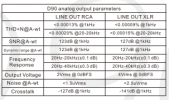Hi there,
I have a Topping D90 DAC which feeds my Musical Fidelity M6si amplifier. There is a fairly small band on the volume control when the volume goes for fairly low to uncomfortably loud very quickly. When the volume control is set to around 9 o'clock its fairly quiet, you can talk but hear the music. If you move the dial to 10 o'clock then it become pretty loud, you are no longer able to talk etc. On another site it had been suggested I might have a gain mismatch between the DAC and amp and that in-line attenuators might be a good solution. I ended up grabbing a pair of xlr Rothwell attenuators to try them out. They are the -20db variety and I have them plugged directly into the amplifier, the XLR cable into the DAC.
They seem to allow me to use more of the volume control but I was unsure if they actually negatively effect the system in any way. So I thought I would put a post up here.
Any thoughts?
I have a Topping D90 DAC which feeds my Musical Fidelity M6si amplifier. There is a fairly small band on the volume control when the volume goes for fairly low to uncomfortably loud very quickly. When the volume control is set to around 9 o'clock its fairly quiet, you can talk but hear the music. If you move the dial to 10 o'clock then it become pretty loud, you are no longer able to talk etc. On another site it had been suggested I might have a gain mismatch between the DAC and amp and that in-line attenuators might be a good solution. I ended up grabbing a pair of xlr Rothwell attenuators to try them out. They are the -20db variety and I have them plugged directly into the amplifier, the XLR cable into the DAC.
They seem to allow me to use more of the volume control but I was unsure if they actually negatively effect the system in any way. So I thought I would put a post up here.
Any thoughts?

